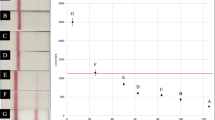Abstract
When testing the Microgenics CEDIA assay for immunological buprenorphine analysis, cross-reactivity between the buprenorphine reagents and opiates was observed at concentrations higher than 120 mg/l morphine, 320 mg/l methadone, 30 mg/l codeine, 60 mg/l dihydrocodeine and 520 mg/l morphine-3-glucuronide. The cross-reactivity with morphine has the greatest impact on routine screening as opiate maintenance therapy in Austria is also performed with slow-release oral morphine. The use of a second cutoff value of 30 μg/l for urine samples that are (immunologically) positive for opiates is therefore suggested, compared to the cutoff value of 5 μg/l proposed by the manufacturer.


Similar content being viewed by others
References
Cone EJ, Preston KL (2002) Toxicologic aspects of heroin substitution treatment. Ther Drug Monit 24:193–198
Dole VP, Nyswander M (1965) A medical treatment for diacetylmorphine (heroin) addiction. A clinical trial with methadone hydrochloride. JAMA 193:646–650
Gschwend P, Rehm J, Blattler R et al (2004) Dosage regimes in the prescription of heroin and other narcotics to chronic opioid addicts in Switzerland—Swiss national cohort study. Eur Addict Res 10:41–48
Der Schweizerische Bundesrat (1999) Verordnung über die ärztliche Verschreibung von Heroin. Verordnung 812.121.6, Betäubungsmittelgesetz 1951
van den Brink W, Hendriks VM, Blanken P, Koeter MW, van Zwieten BJ, van Ree JM (2003) Medical prescription of heroin to treatment resistant heroin addicts: two randomised controlled trials. BMJ 327:310
Das bundesdeutsche Modellprojekt zur heroingestützten Behandlung Opiatabhängiger (2002) http://heroinstudie.de/forschungsdesign_kurzfassung.pdf
Walsh SL, Preston KL, Bigelow GE, Stitzer ML (1995) Acute administration of buprenorphine in humans: partial agonist and blockade effects. J Pharmacol Exp Ther 274:361–372
Jasinski DR, Pevnick JS, Griffith JD (1978) Human pharmacology and abuse potential of the analgesic buprenorphine: a potential agent for treating narcotic addiction. Arch Gen Psychiatry 35:501–516
Bickel WK, Stitzer ML, Bigelow GE, Liebson IA, Jasinski DR, Johnson RE (1988) Buprenorphine: dose-related blockade of opioid challenge effects in opioid dependent humans. J Pharmacol Exp Ther 247:47–53
Giacomuzzi SM, Riemer Y, Ertl M, Kemmler G, Rossler H, Hinterhuber H, Kurz M (2003) Buprenorphine versus methadone maintenance treatment in an ambulant setting: a health-related quality of life assessment. Addiction 98:693–702
Ling W, Charuvastra C, Collins JF et al (1998) Buprenorphine maintenance treatment of opiate dependence: a multicenter, randomized clinical trial. Addiction 93:475–486
Mattick RP, Ali R, White JM, O’Brien S, Wolk S, Danz C (2003) Buprenorphine versus methadone maintenance therapy: a randomized double-blind trial with 405 opioid-dependent patients. Addiction 98:441–452
West SL, O’Neal KK, Graham CW (2000) A meta-analysis comparing the effectiveness of buprenorphine and methadone. J Subst Abuse 12:405–414
Petitjean S, Stohler R, Deglon JJ, Livoti S, Waldvogel D, Uehlinger C, Ladewig D (2001) Double-blind randomized trial of buprenorphine and methadone in opiate dependence. Drug Alcohol Depend 62:97–104
Uehlinger C, Deglon J, Livoti S, Petitjean S, Waldvogel D, Ladewig D (1998) Comparison of buprenorphine and methadone in the treatment of opioid dependence. Swiss multicentre study. Eur Addict Res 4(Suppl 1):13–18
Eder H, Fischer G, Gombas W, Jagsch R, Stuhlinger G, Kasper S (1998) Comparison of buprenorphine and methadone maintenance in opiate addicts. Eur Addict Res 4(Suppl 1):3–7
Fischer G, Gombas W, Eder H et al (1999) Buprenorphine versus methadone maintenance for the treatment of opioid dependence. Addiction 94:1337–1347
Bundesministerium für Soziale Sicherheit und Generationen (1998) Erlass “Orale Substitutionsbehandlung von Suchtkranken”
Kraigher D, Ortner R, Eder H, Schindler S, Fischer G (2002) Slow-release morphine hydrochloride for maintenance therapy of opioid dependence. Wien Klin Wochenschr 114:904–910
Baselt RC (2002) Morphine. In: Basel RC (ed) Disposition of toxic drugs and chemicals in man. Biomedical Publications, Foster City, pp 720–724
Albers C, Kohler H, Lehr M, Brinkmann B, Beike J (2004) Development of a psilocin immunoassay for serum and blood samples. Int J Legal Med 118:326–331
Acknowledgements
The authors would like to thank Mrs. Verena Kuenz and Mr. Karl-Heinz Pramstrahler for their valuable support in the laboratory.
Author information
Authors and Affiliations
Corresponding author
Rights and permissions
About this article
Cite this article
Pavlic, M., Libiseller, K., Grubwieser, P. et al. Cross-reactivity of the CEDIA buprenorphine assay with opiates: an Austrian phenomenon?. Int J Legal Med 119, 378–381 (2005). https://doi.org/10.1007/s00414-005-0544-x
Received:
Accepted:
Published:
Issue Date:
DOI: https://doi.org/10.1007/s00414-005-0544-x




